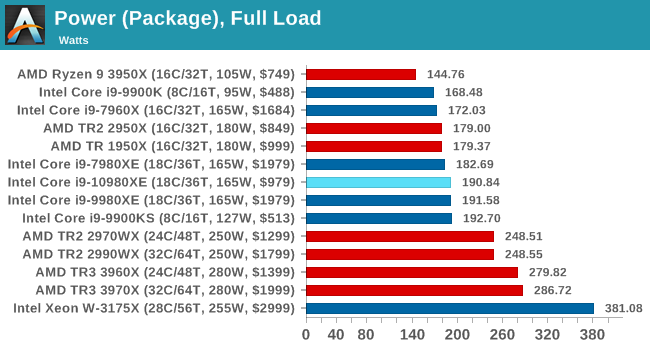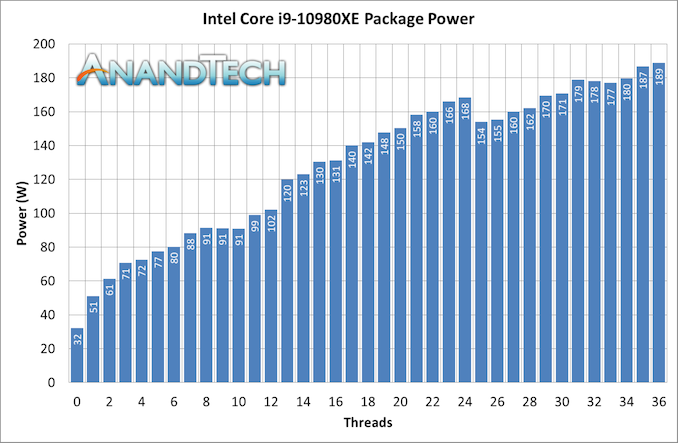It’s a Cascade of 14nm CPUs: AnandTech’s Intel Core i9-10980XE Review
by Dr. Ian Cutress on November 25, 2019 9:00 AM ESTPower Consumption
We’ve covered in detail across multiple articles the story of Intel’s turbo: about how the TDP on the box doesn’t mean a whole lot, the motherboard you’re using can ultimately determine how long your CPU does turbo for, and how the power limits of the processor are ultimately decided by the motherboard manufacturer’s settings in the BIOS unless you change them. Intel only gives recommendations on peak turbo power and the length of the turbo: the only thing Intel defines is the peak frequency based on load when turbo is allowed.
Talking Intel’s TDP and Turbo
Interviewing an Intel Fellow about TDP and Turbo
Comparing Turbo: AMD and Intel
This means that an extremely conservative system might not allow the power to go above TDP, but the system capable of all the power might allow the processor to turbo ad infinitum. The reality is usually somewhere in the middle, but for a high-end desktop platform, where most of the motherboards are engineered to withstand almost anything that comes at it, we’re going to often see the situation of an elongated or persistent turbo.
It’s worth noting that for consumer workloads, most of the work can happen within a reasonable turbo – and thus sustained performance metrics aren’t that important. But today we are testing high-end desktop hardware, and because Intel doesn’t explicitly define peak turbo power or turbo length (it only provides recommendations that motherboard manufacturers can and do ignore), I obviously asked Intel what it believes that reviewers should do when trying to compare performance. The answer wasn’t very helpful: test with a range of motherboards’.
In our previous review of the Core i9-9900KS, I did two sets of tests: benchmarks at the motherboard default, and tests at the Intel recommended turbo settings. The motherboard defaults, for that motherboard in question, were essentially full turbo all the time. Intel’s recommended settings gave some decreases in the long benchmarks, around 7%, but the rest of the tests were about the same.
For this review, we’re using ASRock’s X299 OC Formula motherboard. This is a motherboard designed for high-end and extreme overclocking, and is built accordingly. As a result, our sustained turbo and power limits are set very high. This is a HEDT system, and most HEDT motherboards are built and engineered this way, and so we expect our results here to be consummate with most users’ performance.
For our power consumption metrics, Intel actually does some obfuscation on its high-end platform. Unlike AMD, we cannot extract the per-core power numbers from the internal registers during a sustained workload. As a result, all we get are total package numbers, which show the cooling requirements of the processor but also include the power consumption of the DRAM controller, uncore, and PCIe root complexes.
The TDP of this chip is 165 W – normally Intel recommends a peak power of 1.25x, which would be 207 W, and so the 189 W value we see is under this. The chip we got is technically an engineering sample, not a retail part, although we usually expect the final stepping engineering samples to be identical to what is sold in the market. Despite this, your mileage may vary.
When we compare this peak to other CPUs:












79 Comments
View All Comments
Santoval - Monday, November 25, 2019 - link
Wait for the prices of both to adjust first.Drumsticks - Monday, November 25, 2019 - link
I don't care about process nodes, as long as they're delivering competitive prices, core counts, and performance per core. Intel's not quite out of the game yet since AMD's HEDT goes higher than Intel's, but they've gotten smashed at the halo spot, and they won't be able to deliver on price and performance if they can't get something in order.Braincruser - Tuesday, November 26, 2019 - link
No they haven't been "smashed at the halo spot". The 3900X and 3950X are both beasts and both shred in most of the important benchmarks. For video rendering both the 3900x and 3950X hand out with both the threadrippers and the intels. You get 90% of the performance for 1/4th the price. 12-16 cores is also a very important number for programmers, since you have enough CPUs for compiling, and running 2-3 VMs comfortably.Dolda2000 - Monday, November 25, 2019 - link
Why is it that Intel gains so incredibly much more from AVX512 than AMD gains from AVX2?In the 3DPM2 test, the AMD CPUs gain roughly a factor of two in performance, which is exactly what I'd expect given that AVX2 is twice as wide as standard SSE. The Intel CPUs, on the other hand, gain almost a factor of 9, which is more than twice what I'd expect given that AVX512 as four times as wide as SSE.
What causes this? Does AVX512 have some other kind of tricks up its sleeves? Does opmasking benefit 3DPM2?
Xyler94 - Monday, November 25, 2019 - link
Basically, AVX-512 is double the performance of AVX2 (or another way to see it, 256bit vs 512bits, which 512 is double 256). So anything optimized for 512 will be about double in speed from 256, even on the exact same processor.Xyler94 - Monday, November 25, 2019 - link
To note: That's a highly overly simplistic view of it, there's a lot more under the hood.eek2121 - Monday, November 25, 2019 - link
Well that and the obvious point that AMD CPUs do not support AVX-512.DanNeely - Monday, November 25, 2019 - link
AVX-2 is 256 bits wide, and thus only does have as much/instruction as AVX-512.JayNor - Monday, November 25, 2019 - link
I believe for 10 cores and up there are dual avx512 units per core. You can see the dual avx512 units in the Execution Engine diagram at this link.https://en.wikichip.org/wiki/intel/microarchitectu...
Also, cascade lake added dlboost 8 bit operations in avx512 to support ai inference convolutions.
Dolda2000 - Monday, November 25, 2019 - link
But Zen 1/2 also has two 256-bit FMAs per core. And Intel also has two SSE units per core as well, so I don't see how that would explain the ratios.